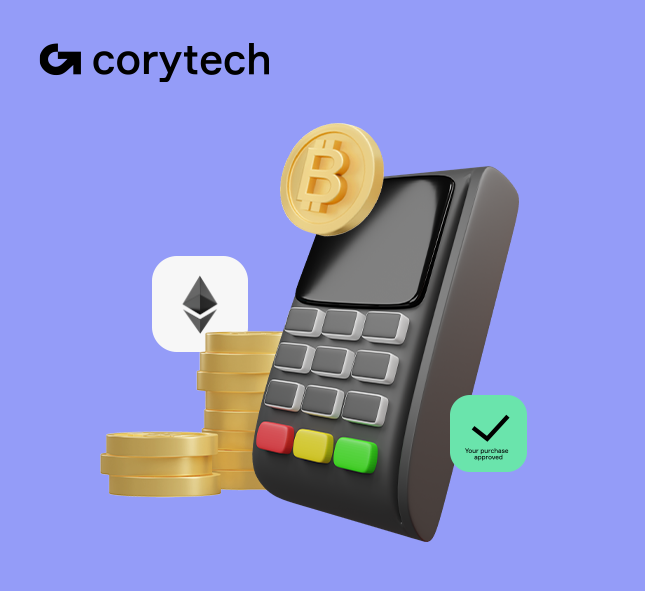In an era where digital currencies are changing the financial world, meeting the nuances of cryptoprocessing has become crucial for enterprises and individuals alike. Now, we'll dive into the intricacies of crypto-fiat, crypto-crypto, and fiat-crypto models, providing a clear overview of each process. By exploring their mechanisms, perks, and challenges, readers will understand the diverse world of cryptocurrency operations and how they can navigate it effectively.
Crypto-to-Fiat Processing
Definition and Mechanics
Crypto to fiat processing is the bridge between digital and traditional fiat money. These models allow for converting cryptocurrencies like Bitcoin into fiat currencies such as USD, EUR, or GBP through platforms that act as intermediaries.
Advantages and Use Cases
The primary benefit of crypto-to-fiat transactions is their ability to integrate digital assets into the classic economy, offering liquidity and flexibility for cryptocurrency holders. Real-world applications range from online purchases to remittances and payroll services.

Challenges and Considerations
Navigating the realm of crypto to fiat processing presents unique dares and considerations that participants must address:
- Volatility: The value of cryptocurrencies can undergo rapid and significant changes, affecting the conversion rate to fiat currencies. This volatility requires careful timing and market analysis to maximize the importance received.
- Regulatory Compliance: As cryptocurrency gains mainstream acceptance, regulatory bodies increasingly scrutinize transactions. Adhering to these regulations, including AML and KYC requirements, is crucial for businesses and individuals engaging in crypto-to-fiat conversions.
- Transaction Fees: Transaction fees can differ significantly depending on the platform or service used for conversion. These fees can impact the overall efficiency and cost-effectiveness of the conversion process.
- Platform Reliability and Security: Choosing a reliable and secure platform for crypto-to-fiat transactions is vital. The security criteria implemented by the platform protect users from theft and fraud.
Best Practices for Crypto-to-Fiat Conversion
To guide the complexities of crypto-to-fiat processing effectively, participants should consider the following best practices:
- Stay Informed About Regulatory Changes: Keeping abreast of the latest regulatory developments in the cryptocurrency space can help ensure compliance and avoid potential legal issues.
- Choose Reputable Platforms: Select platforms known for their reliability, security, and favorable conversion rates. Researching user reviews and security features can aid in making an informed decision.
- Implement Risk Management Strategies: Given the instability of cryptocurrencies, employing risk management strategies such as setting stop-loss orders or converting in tranches can help protect against market downturns.
- Understand the Tax Implications: Crypto-to-fiat conversions may have tax implications, including capital gains tax. Consulting with a tax professional can provide clarity and help in planning and reporting taxes accurately.
Future Trends in Crypto-to-Fiat Processing
The field of crypto to fiat processing is constantly developing, driven by technological advancements, regulatory changes, and shifts in consumer behavior. Forthcoming trends to watch include:
- Increased Regulatory Clarity: As governments and financial rules develop more explicit frameworks for cryptocurrency regulation, enterprises, and individuals can expect a more stable environment for crypto-to-fiat operations.
- Integration with Traditional Banking Systems: The growing approval of cryptocurrencies may lead to closer integration with conventional banking and financial systems, making conversions smoother and more accessible.
- Technological Innovations: Innovations like DeFi platforms and stablecoins are poised to streamline the conversion process, offering more efficient and cost-effective solutions for crypto-to-fiat processing.
Crypto-to-Crypto Processing
How it works
Crypto to crypto processing facilitates the exchange of one cryptocurrency for another. This model operates primarily through crypto exchanges and may involve direct peer-to-peer transactions without the need for traditional financial negotiators.
Advantages and Use Cases
This model supports the diverse digital cash ecosystem, allowing users to trade across different crypto assets. It's vital for investment strategies, portfolio diversification, and access to niche cryptocurrencies.
.png)
Challenges of Crypto-to-Crypto Processing
The crypto-to-crypto exchange model, while offering numerous advantages, also presents specific challenges that need to be navigated carefully:
- Security Risks: Engaging in crypto to crypto transactions, especially on crypto exchange platforms, exposes users to security risks such as hacking, phishing attacks, and smart contract vulnerabilities. Ensuring the security of transactions and wallet keys is paramount.
- Market Liquidity: Depending on the cryptocurrencies involved, market liquidity can significantly impact the ease and speed of transactions. Trading less popular or newer cryptocurrencies may pose challenges due to lower trading volumes, affecting the ability to execute trades at desired prices.
- Complexity for Beginners: The technical origin of crypto-to-crypto operations and decentralized platforms can be intimidating. The absence of a centralized authority or support system requires users to understand how these transactions work.
Navigating Security in Crypto to Crypto Transactions
To mitigate security risks associated with crypto-to-crypto payment processing, participants should:
- Use reputable exchanges and platforms with strong security records.
- Employ 2FA and hardware wallets to secure assets.
- Stay informed about common scams and phishing tactics to avoid fraud.
- Regularly update and review security practices and protocols.
Future Directions in Crypto-to-Crypto Exchanges
The future of crypto-to-crypto processing is likely to be shaped by:
- The continued growth and development of decentralized exchange (DEX) platforms enhance security and user control over assets.
- Technological advancements simplify the trading process, making it more accessible to a broader audience.
- Increased integration of cross-chain technologies facilitates seamless transactions between different blockchain networks, thereby expanding trading opportunities and market liquidity.
.png)
Fiat-to-Crypto Processing
Mechanics of Fiat-Crypto Processing
Fiat-to-crypto processing is the ‘gateway’ for integrating traditional economies with the burgeoning world of digital currencies. This essential mechanism enables the conversion of fiat money—such as US dollars, euros, or pounds—into cryptocurrencies via regulated exchanges and platforms. These platforms serve as the critical infrastructure, ensuring individuals can securely and efficiently enter crypto by purchasing digital assets with their traditional currency.
Advantages and Use Cases
The primary advantage of fiat to crypto model is accessibility. It democratizes entry into the cryptocurrency market, allowing anyone with traditional bank accounts to participate in digital asset trading and investment. Use cases include first-time investments in cryptocurrencies, using fiat reserves to engage in trading activities, and purchasing digital currencies for online transactions or as a store of value.
-(4).png)
Challenges and Considerations
However, navigating fiat-to-crypto transactions involves understanding specific challenges:
- Regulatory Scrutiny: As the entry point for traditional finance into crypto, these transactions are heavily monitored for AML and KYC compliance.
- Exchange Fees: Transaction fees can vary widely among platforms, impacting the cost-effectiveness of converting fiat to crypto.
- Security Concerns: The security measures of exchanges are paramount, given the risks of hacking and fraud in the digital currency space.
Security Best Practices
Ensuring the security of fiat to crypto transactions is crucial. Users should:
- Choose exchanges with robust security measures, including two-factor authentication and cold storage options.
- Be aware of phishing scams and only use trusted platforms.
- Regularly monitor their accounts for any unauthorized activity.
Market Trends and Future Outlook
The fiat-to-crypto processing landscape is continually evolving, influenced by regulatory changes, technological advancements, and shifts in market demand. Staying informed about these trends is essential for participants seeking to navigate this space effectively.
Comparing Exchange Models
Key Differences
Comparing crypto-fiat, crypto-crypto, and fiat-crypto models highlights critical differences in accessibility, regulatory oversight, transaction speed, and fees. While crypto to crypto offers speed and potentially lower costs, fiat-related models provide broader accessibility but have higher regulatory scrutiny and variable expenses.
Choosing the Right Model & Payment Processor for Your Needs
Selecting the appropriate model and payment processor depends on individual needs, such as the desire for speed, ease of use, regulatory compliance, and security. Factors to consider include trade fees, processing times, and the geographical availability of services.
-(4).png)
Integrating Multiple Models for Flexibility
Integrating multiple models can offer flexibility for companies and individuals, allowing them to optimize transactions according to their needs at any time.
Future Innovations in Crypto Payment Processing
The future of cryptoprocessing is likely to see innovations that streamline transactions, enhance security, and improve regulatory compliance, further bridging the gap between traditional and digital finance.
Crypto Processing FAQ
Can I convert Fiat to crypto?
Yes, fiat to crypto conversions are facilitated by numerous exchanges and platforms, allowing individuals to purchase cryptocurrencies with traditional money.
What is the best way to transfer fiat to crypto?
The best method depends on individual speed, fees, and security needs. Utilizing reputable and regulated exchanges is generally advisable.
Which payment gateway supports crypto?
For certain transactions, several fiat to crypto payment gateways support crypto transactions, including Coinbase Commerce, BitPay, and PayPal. Choosing one depends on your specific requirements, such as supported currencies and geographical availability.
What’s Next?
As the crypto landscape evolves, understanding the various processing models becomes crucial for anyone looking to engage with digital currencies effectively. Whether you're a newcomer seeking to invest in your first digital asset or a business exploring payment integration, the key is to stay informed and choose the models and platforms that best suit your objectives.
Ready to explore the possibilities of cryptocurrency processing for your business? Request a personalized demo today to discover how Corytech can help you navigate the complexities of crypto-fiat, crypto-crypto, and fiat-crypto transactions, ensuring secure, efficient, and compliant operations.







 Payments
Payments
 Solutions
Solutions
 Industries
Industries
 Services
Services
 Resources
Resources

-(26).png)










